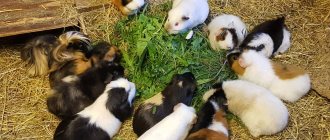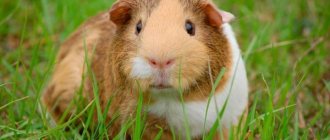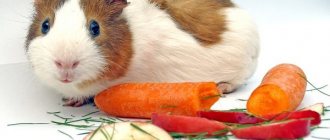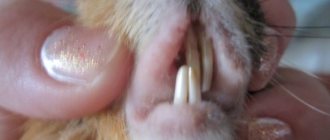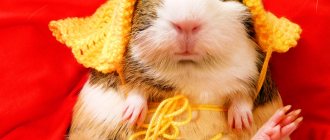Guinea pig and hamster are interesting and inquisitive animals. Both pets will definitely bring joy and fun to your home and will not let you get bored. The choice of a pet depends entirely on you: on your financial capabilities, on the available time for care, on the “requirements” for the pet, etc. Below you can get acquainted with the characteristics of each animal and the fundamental differences between them, which will help you make the right decision.
Guinea pigs are very friendly, while hamsters have an independent character
Who is better: a guinea pig or a hamster - the pros and cons of animals
Both animals - a guinea pig and a hamster - are playful and nimble animals that can create a cheerful and cozy atmosphere in the house. To make a choice, you should take into account the pet’s temperament, as well as the characteristics of care and maintenance.
What's good about a guinea pig?
Guinea pigs are easy to care for and maintain, as well as quick adaptation. The main advantages of these animals include:
- unpretentiousness in keeping and ease of caring for the pet (the main thing is to feed the animal and clean its cage);
- training opportunity;
- absolute absence of aggression ( pigs never bite or scratch their owners . By nature they are quite cowardly animals, so even for the purpose of self-defense they will not show aggression, but will try to squeeze themselves into a ball and hide);
getting along with other pets (pigs are very friendly, they quickly find contact with both other rodents and larger pets: cats, dogs)
- the possibility of keeping guinea pigs in same-sex pairs ( these fluffies are not inclined to show aggression towards their brothers, they do not have the instinct to fight for a cage or leadership , so two females or two males will get along well in one cage);
- love of affection and tenderness (these furry animals simply adore being stroked and scratched; they express their pleasure with the help of various touching sounds);
- talkativeness ( you simply cannot forget that your pet needs to be fed. A vocal pig will definitely remind you of itself with various interesting sounds when it wants to eat).
Cons of Guinea Pigs
- animals need constant attention and painfully endure loneliness (in the absence of attention and affection from the owner, they will become depressed, become lethargic, immobile and even lose their appetite);
- strong odor (the waste products of guinea pigs (in particular urine) have a fairly strong and specific odor, so the cage must be cleaned regularly).
What's good about a hamster
The hamster is an active animal that can create real circus performances at home. The main advantages of a small pet are:
- independence from communication with the owner (hamsters do not require much attention; they are used to living on their own);
compact dimensions (the size of the animal, and therefore the cage required for it, will not particularly crowd you out even in a small room)
- unpretentiousness in care (feeding and cleaning are two basic rules for caring for a hamster);
- affordable price ( hamsters are one of the most financially affordable pets. On average, a hamster can be purchased for 100-300 rubles without any problems, and due to their fast and high fertility, there is a high probability that you will get a furry baby for free).
Cons of hamsters
- waywardness (hamsters have a rather finicky character. If something is done not according to their wishes, these little fluffies can easily bite);
- solitary animals (this applies to both their isolated attitude towards the owner and their reluctance to have neighbors in their cage. The life of a hamster is built on the principle of “one cage - one hamster”; attempts to change this principle are unlikely to be successful. The animal will defend its territory, between neighboring pets will constantly fight.In addition, hamsters will be more aggressive towards the owner due to the general tense atmosphere).
Guinea pigs are much larger than hamsters
Who smells more, the female or the male?
And yet, like any animal, guinea pigs are also not without their natural smell. Many people wonder: who is better to choose, a female or a male? Does a male guinea pig stink? Or does the female smell more?
Of course, differences by gender determine various physiological characteristics, including the emitted odor. Males, when excited, courting a female or marking, emit a pungent odor that does not depend on the cleanliness of the cell. Each person relates to this smell differently. Many owners note that it goes away quickly and is not that strong. However, for some it is still quite unpleasant.
The female may begin to smell after giving birth due to hormonal changes. However, this phenomenon is transitory and for owners who love their pet, this is not a disaster.
What is the difference between a hamster and a guinea pig?
Despite belonging to the same order and almost equally popular for home breeding, these animals have a number of fundamental differences:
- size is the first difference that immediately catches your eye. Compared even to the Syrian hamster (the largest breed of domestic hamster), the guinea pig looks much larger ;
- lifestyle is the most important difference and often plays a decisive role when choosing a pet. The fact is that hamsters are nocturnal inhabitants, so you can only observe their active period of life in the late evening or at night, since small rodents sleep most of the day. Guinea pigs are more active during the day and rest at night . This is not to say that pigs sleep all night. Their sleeping style is very interesting - due to their increased fearfulness, pigs sleep for 10-15 minutes several times a day;
Nutrition - there is a difference both in the amount of food consumed and in the diet itself. A hamster needs much less food than a pig. You should feed him once a day, in the late afternoon, and regularly pamper him with cheese, lettuce leaves, meat or slices of bananas. Unlike hamsters, guinea pigs should not be given meat, cheese or potatoes. The pig should be given food 2 times a day - morning and evening. The main delicacy for pigs is fresh cucumber, sweet pepper and apple. A general rule for both rodents: there should be branches of fruit trees in the cage so that the pets can grind down their teeth
- life expectancy - rodents have a significant difference in this criterion. Guinea pigs live much longer: their average lifespan with proper care is 5-7 years. Hamsters rarely live past three years;
- learning ability - in this case, guinea pigs have an advantage. These animals are easy to train, so if desired, pigs can be trained to perform tricks of varying degrees of complexity. A trained pig can recognize its owner, follow him, roll a small ball with its muzzle, and also stand on its hind legs ;
- home - the difference is in the size of the cage, as well as its contents. A guinea pig needs a spacious cage in which it can lead an active lifestyle, since inactivity often leads to obesity. The cage should have a house or hammock in which the pig can sleep or hide. It is not necessary for a hamster to purchase a spacious cage; the main condition is the presence of various labyrinths and a running wheel in the cage. Like a guinea pig, a hamster needs a place to sleep and hide. It is important that the hamster’s house needs to be cleaned regularly, because this thrifty animal tends to carry and hide food that can quickly spoil;
- walk: you should not let your hamster out for a walk around the house - he will definitely be attracted to some hard-to-reach place that will vaguely remind him of a hole. Getting the baby out of there will be a real challenge, so you need to let the hamster go for a walk only in a special ball, which can be purchased at a pet store. With a guinea pig, things are much simpler - you can and even need to let him go for a walk . Catching it will not be difficult due to its large size and slowness.
Children under 3 years old should not have a pet at all.
How to care for your pet to avoid unpleasant odor
Potential breeders of these furry animals, along with the question of whether guinea pigs stink, should also be interested in the question of how to properly care for their animals in order to avoid an unpleasant odor. So, the basic rules of care:
- Correctly selected cell size. A larger home will stay cleaner longer. The size of the cage should allow the animal to allocate a separate corner where it will relieve its needs.
Should I buy a guinea pig or a hamster for my child?
These pet rodents are living sources of fun and happiness for both adults and children. If you want to get a pet for a child, you need to take into account the age and character of the future owner.
It is better for children under three years old not to have pets at all, because this is not yet the most conscious age of a child, let the kids grow up a little.
Guinea pigs are perfect for children aged three years and older. These pets get along well with children and are friendly and playful. The absolute absence of aggression is also important to consider, because young children do not always know the limits and limits when playing with pets, to which a hamster, for example, can respond with a sharp bite. But older children can already choose a hamster as a pet.
He will become a good friend for schoolchildren. Do you have a small child in the house?
The choice of a pet animal also depends on the purpose of its establishment. If your child wants to watch the animal and its antics, then a hamster is an ideal option. This little fluffy, running in a wheel and through its labyrinths, can stage real circus performances. If a child wants a tame animal that can be constantly squeezed and stroked, then it is better to opt for a guinea pig. They are very social, so even excessive attention will only be a joy for them.
Another point to consider when choosing a pet for your child is the possibility that family members may be allergic to wool. If someone in the family has it, then it is better to forget about the pet hamster. But the pig is worth considering, since there are hypoallergenic breeds of these rodents - hairless skinny pigs.
Choosing a pet
Both animals are similar in terms of care and nutrition. Differences are noticeable in abilities and character. The pig is easy to train, and hamsters do not like to be treated too closely.
With quality care, pigs live up to 6 years, and hamsters reach old age as early as one year. The hamster feels great alone, unlike the pig, for which this option is unacceptable.
Both animals are more common pets than the rodent degu, the common gerbil or the chinchilla. You can play with it or watch the antics of animals. If your baby likes to pet his pet, then a pig will do, but hamsters generally value freedom.
It doesn’t matter which pet the choice was made for. But for any animal it is necessary to provide high-quality and decent care.
Benefits of a Pet Rat
- You can easily pick them up to play. After all, they are not as fragile as small fluffies. This means that they are perfect for children who are not particularly careful in their actions.
- These animals do not bite as often as hamsters. They can bite only if they are very scared. They stay awake during the day and adapt perfectly to the daily routine of their owners.
- More sociable than hamsters, they will happily sit on their owner’s shoulder. It is better to house them in pairs, as life will be more fun, and you will be able to watch them play.
- These rodents are very smart and can easily be taught some tricks.
Which rodent is best to get?
Since the list of ornamental rodents is quite extensive, potential owners will have plenty to choose from.
You should not bring large animals that need to run outside the cage into a small apartment. Therefore, gerbils, hamsters or rats are more suitable for residents of small-sized apartments. Unlike decorative rabbits, these small domestic rodents do not require walking around the apartment and feel great in a cage.
Owners of spacious cottages, on the contrary, are not recommended to acquire miniature rats or mice. There is always a risk that decorative pets living in a large house will become acquainted with their wild counterparts. And tiny hamsters can get scared and get lost in the attic, closet or basement. Therefore, it is better to have a chinchilla, guinea pig or decorative rabbit in the house.
When choosing a pet, it is important to consider not only the area of the home, but also the degree of readiness for additional troubles. Even small pet rodents require regular bedding changes and cage cleaning
Gerbils and chinchillas are considered the cleanest. These animals do not need frequent cleaning of the tray and do not have a specific smell.
Since small animals are often purchased for a child, the choice falls on unpretentious, peaceful animals that live longer than 2-3 years. Children show particular interest in chinchillas, guinea pigs and decorative rats. But rabbits need complex care, which not every child can afford. Hamsters are not the best gift for children.
These small pet rodents are introverts by nature and will not be able to find a common language with active children. In addition, they do not live long and their death will cause psychological trauma to the children.
Domestic rodents are charming and peaceful animals that are fun to watch. Many of them easily find a common language with people and are quite trainable.
I like2I don't like
External characteristics and description
The forest hamster looks like a domestic hamster. The difference lies in the size of the animals. Wild animals are much larger. Boys reach 40 cm in length, girls are smaller. The weight of such a hamster is slightly less than a kilogram.
The animal's neck is almost invisible. The head smoothly flows into the rounded body. The rodent's fur is dense with undercoat. There are small ears on the head. The animal's legs are short but powerful. At the ends of the paws there are sharp, hard claws, with the help of which the animals dig the ground.
The rodent's mouth contains sharp, constantly growing teeth. An animal bite is quite dangerous. A cute hamster can leave a wound with ragged edges and also cause a dangerous infection.
There are hard antennae on the muzzle. The eyes of the animal are black. The coat color is quite varied. The most common are brown and yellow animals. Sometimes there are representatives with black, white or spotted coats.
Harm to farms
Wild hamsters cause enormous harm to farmers, summer residents and gardeners. Rapid reproduction, omnivory, and the ability to “build” complex dwellings make pest control much more difficult. Hamsters' housing reaches 150 cm in depth and 800 cm in width. There are known cases when reserves of 90 kg were found in rodent burrows.
Theft and destruction of crops are not the only problems that wild animals cause. Their bites are extremely dangerous to humans, pets and livestock. A rodent can infect more than 30 different diseases, including fatal ones. Wild hamsters can become infected with parasites that live in their fur coat. Fleas also carry various diseases.
Preparing the cage for newborns
Preparing the cage for the babies begins a few weeks after mating. Most often, they start with putting things in order - the bars of the cage are cleaned, the bedding is replaced with new ones, and all drinking bowls are disinfected.
It is important to remember that as the due date approaches, the female may become very nervous and your intervention may cause stress. Experienced breeders also categorically do not recommend cleaning the cage in the first two weeks after the birth of the offspring - in a state of stress, the female can harm the babies and even eat them
Did you know? Hamsters need voluminous cheeks not only for storing food. These rodents are good swimmers - they take air into their cheeks and thus float well on the water.
Do not forget that all toys of adult hamsters, for example, a wheel, can pose a danger to newborns, because by the end of the first week of life, little hamsters already begin to show curiosity. Don't forget to throw some clean napkins or pieces of paper so that the expectant mother can build a nest. These materials are soft, and they retain heat well, so the hamsters will be comfortable and safe in such a nest.
Rat
Recently, the rat has become a popular pet rodent. Many people are disgusted by this animal because of the habitat of their wild relatives and also the prejudiced attitude towards them. But pet rats are safe for humans.
They are very sociable, easily tamed, understand their name, can learn some commands, and practically do not bite. When kept at home, these animals can live 2-3 years. They do not require special nutrition - they are omnivores. And you will have to clean the cage more often to get rid of the unpleasant smell. These pets can be kept in pairs. You can read more about keeping rats in. Rats need to be physically active, so they need to be allowed to roam outside their cage. But they require much more attention than other domestic rodents.
Learn more about the difference between a hamster and a domestic rat.
But a mouse can not often be found as a pet. Although they are well worth attention. After all, representatives of this class of rodents are unpretentious in keeping, quickly adapt and practically do not bite. In addition, these animals are very funny and playful.
These tiny animals are predominantly nocturnal. With good care they can live for about two years. Mice are herd animals, so if you only have one individual, then take care of entertainment for your pet - balls, cubes or other toys.
Mice are omnivores, but you should not overfeed them with sweets, fatty and spicy foods - this can lead to diseases.
These rodents have one drawback - a specific smell that does not disappear even with very good care. In addition, they reproduce very quickly.
Gerbils are tiny, unpretentious, easily tamed domestic rodents with a long, bushy tail. At home, they are usually kept in pairs, as they are social animals that love communication. Gerbils need a spacious cage or aquarium, as they are a very active animal, or put a running wheel in the cage.
You need to pour a thick layer of bedding into the cage so that the animal has the opportunity to dig into it. These rodents need sand baths, so place a container with special sand in the cage, which needs to be changed periodically.
The lifespan of gerbils is 3-4 years. The food is the same as .
Which hamster is better to get: characteristics of popular species
The most popular rodents that can be kept at home include the following breeds:
- Djungarian is a common species. They have gray fur with a dark stripe on the spine and are classified as dwarf because they do not grow more than ten centimeters. Compared to other breeds, they are best tamed, but due to their small size, it is better not to have them in homes with children of kindergarten age - the nimble animal can slip out of children’s hands and get injured. Suitable for children from 10 years old.
- The Campbell breed looks practical in appearance, like the Djungarian, but their character is quite capricious and they bite. Individuals have a more yellow color and a paler stripe on the back.
- Roborovsky's hamsters are one of the smallest and rarest representatives (adult animals are no larger than 6 cm). A characteristic difference is socialization; they get along with same-sex relatives in the same cage. Kids will have fun watching a bunch of rodents, but they are unlikely to be able to pick them up - they are shy.
- Among Syrian hamsters, the royal hamster is the largest representative of the breed. Adults can be compared in size to a guinea pig. A distinctive feature is that they respond to the sound of their nickname. They are quite hardy in terms of physical health and life expectancy is 3–4 years. If you want to get a rodent for your home, then choose them, but remember - if handled roughly, they will show retaliatory aggression. The coat has different lengths - Angora with long hair and short-haired. Color - from golden to black. The only inconvenience is that they need a large cage. A 7-9 year old child can handle this animal on his own.
- The grasshopper (scorpion) hamster is a wild predator that eats even lizards or scorpions, and is solitary by nature. Therefore, zoologists do not recommend purchasing it for children.
- Siberian (White Russian Dwarf). It differs in that it changes the color of its coat depending on the time of year. It grows up to 10 centimeters and gets along well with people and is friendly.
- Eversmann's hamster is a wild field animal reaching a length of 16 centimeters. It is extremely rare in captivity and is asocial, so it should not be given to children.
Red-eyed albinos are found in every breed. You should not be afraid of them - the unusual color is explained by genetic changes. Such animals are healthy and no different from other “colored” relatives.
https://youtube.com/watch?v=EB_qaEClMWw



